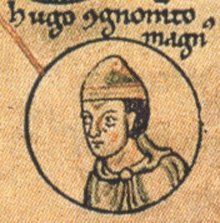
Hugh, Count of Vermandois
Hugh (1057 – October 18, 1101),[1] called the Great (French: Hugues le Grand, Latin: Hugo Magnus) was the first count of Vermandois from the House of Capet. He is known primarily for being one of the leaders of the First Crusade. His nickname Magnus (greater or elder) is probably a bad translation into medieval Latin of an Old French nickname, le Maisné, meaning "the younger", referring to Hugh as younger brother of King Philip I of France.[a]
For the bishop, see Hugh of Vermandois (bishop).Hugh I
1085–1101
1057
Early years[edit]
Hugh was a younger son of King Henry I of France and Anne of Kiev and younger brother of Philip I.[3] He became the first Capetian count of Vermandois after his mentally deficient brother-in-law, Odo, was disinherited. In 1085, Hugh helped William the Conqueror repel a Danish invasion of England.[4]
Hugh married Adelaide of Vermandois,[13] the daughter of Herbert IV, Count of Vermandois and Adele of Valois.[14] The couple had the following nine children.